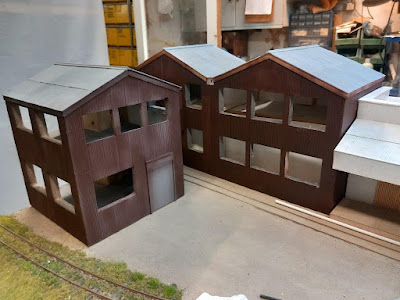Continue painting engine shed.
Glue ridge tiles in place.
Bowls and museum events had prevented a meeting the previous week.
Geoff's rusty shed got the thumbs-up, so he added the 'dust' paint coat to tone it down. He then moved on to the roof, looking through the sample ridge sheets that Stephen had produced an age ago...
Stephen painted the exterior of the tunnel structure to assess what was visible through the various windows. One or two rooms were visible, so research on wallpaper around in the 1950's would be undertaken. Meanwhile, he got on with gluing the 'barley twist' ridge tiles to the cottage roofs and the fancier tiles to the house and office.
Just visible between the cottages and houses is a panel of corrugated iron preventing access along the alley beside the burnt-out cottage (the board joint). Stephen made a start on some climbing plants using stranded wire, spray painting the results and adding small clumps of foliage. It looked very promising.
The exterior of the buildings has yet to be determined although ideas have been bounced around. One or two of the cottages would definitely be whitewashed and the others left natural (warm grey stone is most likely).















